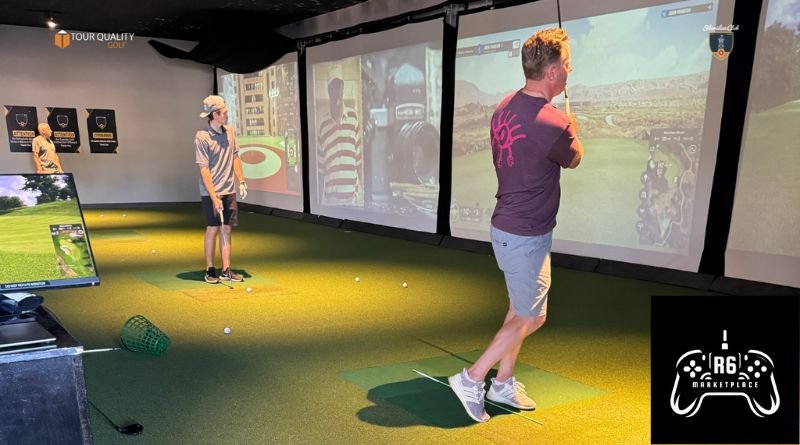Golf simulators have revolutionized the way golfers practice and play the game. Whether you are an amateur looking to improve your swing or a seasoned golfer seeking to maintain your form during the off-season, mastering the golf simulator can take your game to the next level. With advancements in technology, these simulators provide a near-authentic golfing experience indoors, allowing players to refine their techniques and enjoy a round of golf without stepping onto a physical course. In this guide, we will explore everything you need to know about golf simulators, from understanding their components to maximizing their benefits.
Understanding the Golf Simulator: What It Is and How It Works
A golf simulator is a system that replicates the real golfing experience indoors using a combination of sensors, cameras, projectors, and software. These systems track ball speed, launch angle, spin rate, and other critical data points to simulate realistic ball flight and interaction with virtual courses. A high-quality golf simulator consists of the following components:
- Launch Monitor: The core component that captures essential ball and club data.
- Hitting Mat: Mimics the feel of a real fairway or turf for a realistic striking surface.
- Projector and Screen: Displays the virtual golf course and provides immersive visuals.
- Computer Software: Processes data to create an authentic golfing experience.
- Enclosure or Netting: Ensures safety by preventing the ball from hitting surrounding objects.
By combining these elements, golf simulators provide a highly accurate representation of a real golf course, enabling players to analyze their performance and improve their skills.
Benefits of Using a Golf Simulator
Using a golf simulator offers numerous advantages that can help golfers of all skill levels enhance their game. Some of the key benefits include:
- Year-Round Playability
One of the biggest advantages of a golf simulator is the ability to play and practice golf regardless of weather conditions. Whether it’s raining, snowing, or too hot outside, a simulator allows you to enjoy the game in the comfort of your home or a dedicated facility.
- Instant Feedback and Data Analysis
Golf simulators provide real-time data on every shot, including club speed, ball spin, launch angle, and carry distance. This instant feedback helps golfers identify strengths and weaknesses, enabling them to make adjustments and refine their swings.
- Convenience and Time-Saving
With a simulator, there’s no need to drive to a golf course, book tee times, or spend hours playing a full round. You can practice at any time, even for short sessions, making it easier to integrate golf into a busy schedule.
- Enhanced Training and Skill Development
Many golf simulators come with built-in training modes, challenges, and drills designed to improve specific aspects of your game. From perfecting your short game to working on long drives, these tools help golfers develop skills more efficiently.
- Playing World-Class Courses Virtually
High-end simulators feature virtual recreations of famous golf courses worldwide. This means you can play iconic courses like Pebble Beach, St. Andrews, or Augusta National without leaving your home.
Tips for Mastering the Golf Simulator
To get the most out of your golf simulator experience, follow these essential tips:
- Set Up Your Simulator Correctly
Ensuring a proper setup is crucial for accurate readings and an immersive experience. Place the launch monitor at the correct distance, ensure proper lighting, and calibrate the sensors according to manufacturer guidelines.
- Use Real Golf Balls and Quality Equipment
For the most realistic feel and accurate data, use real golf balls instead of foam or plastic ones. Also, use the same clubs you would use on a real course to maintain consistency in your game.
- Focus on Your Swing Mechanics
Since simulators provide precise data, use this to analyze and refine your swing mechanics. Work on improving your club path, face angle, and impact position to develop a more consistent and powerful swing.
- Utilize the Training Features
Many simulators offer various training modes, including driving range practice, short-game drills, and putting challenges. Take advantage of these features to target specific areas for improvement.
- Play Regularly to Build Consistency
Like traditional golf practice, consistency is key to improvement. Regularly using the simulator will help build muscle memory, improve accuracy, and enhance overall performance.
Choosing the Right Golf Simulator for Your Needs
With numerous golf simulator options available, choosing the right one depends on factors such as budget, space, and skill level. Here are some things to consider when selecting a simulator:
- Budget Considerations
Golf simulators range from affordable home setups to high-end professional systems. Entry-level models may cost between $500 and $2,000, while premium options can exceed $20,000. Determine your budget before investing.
- Space Requirements
Ensure you have enough space for a full swing. Ideally, a room should have at least 10 feet in width, 10 feet in depth, and a ceiling height of 9 to 10 feet to accommodate full swings safely.
- Accuracy and Technology
Higher-end simulators provide more accurate data and better graphics. Consider factors like sensor type (radar vs. camera-based), software compatibility, and the availability of course selections.
- Portability vs. Permanent Setup
If you need a portable option, some simulators are designed to be easily assembled and disassembled. Others require a permanent installation, making them better suited for dedicated golf rooms.
Common Mistakes to Avoid When Using a Golf Simulator
While golf simulators are excellent training tools, some common mistakes can hinder progress. Here’s what to avoid:
- Ignoring Data Analysis: Simply hitting balls without analyzing the data won’t help much. Use the information provided to make necessary adjustments.
- Not Adjusting Swing to Simulator Conditions: The feel of hitting into a screen is different from an outdoor course. Adapt your swing while maintaining proper technique.
- Using Poor Quality Mats and Balls: Inferior mats and practice balls can affect feedback and reduce accuracy. Invest in high-quality equipment for the best experience.
- Neglecting Short Game Practice: Many golfers focus on driving distance but ignore chipping and putting. Use simulator features that enhance your short game.
Conclusion: Elevate Your Game with a Golf Simulator
Mastering the golf simulator is an excellent way to improve your skills, enjoy year-round play, and experience world-famous courses from the comfort of your home. By understanding how these systems work, utilizing their features effectively, and avoiding common mistakes, you can make the most of your simulator practice. Whether you are a beginner or an advanced golfer, integrating a simulator into your training routine can lead to significant improvements in your overall game. So, set up your simulator, analyze your data, and start perfecting your golf skills today!
May Also Read: r6marketplace

